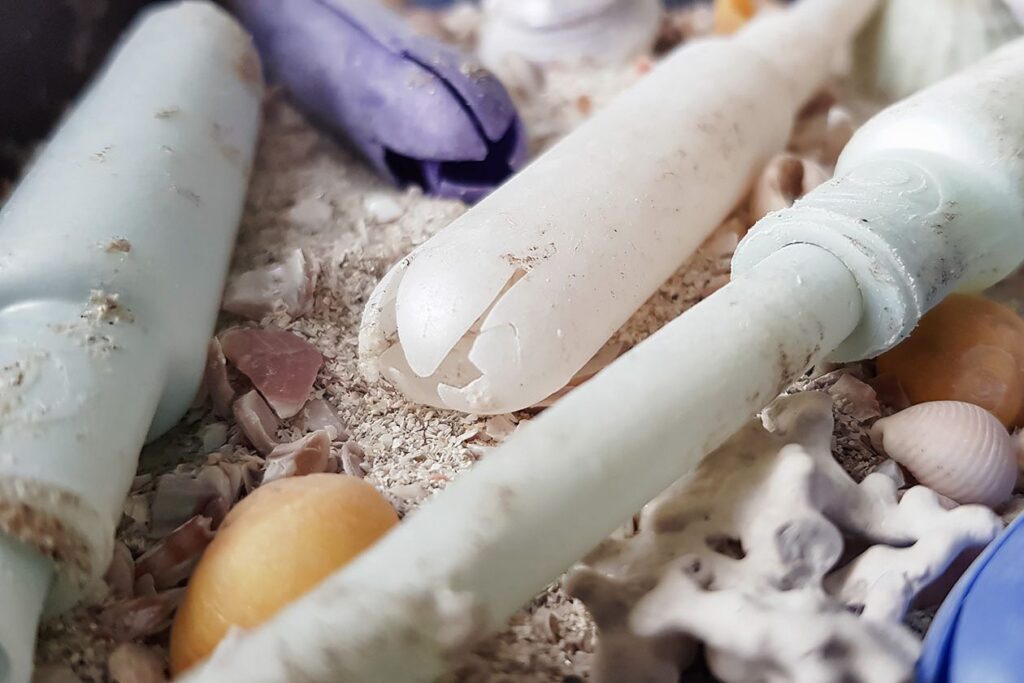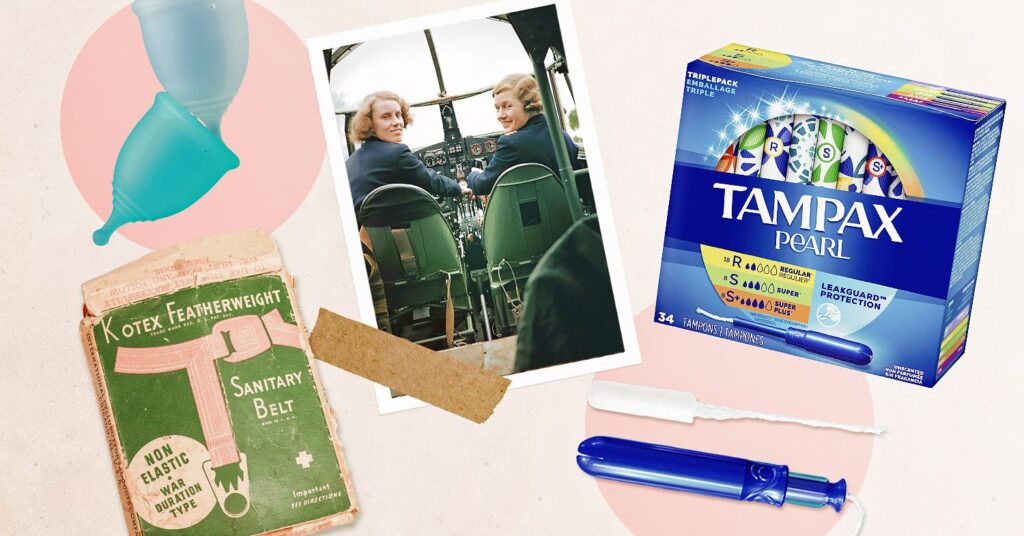Before the second World War, people weren’t sure if women could handle being in the Air Force. They were too “highly strung,” the chief of the U.S. Army Air Corps once said. There was also the issue of menstruation. The “issue,” of course, was some men’s fear and confusion over bodies that worked differently from theirs.
“Women pilots were told they had to stay grounded when they had their periods,” says Sharra L. Vostral, a professor of history and science and technology at Purdue University. “If women had cramps they were supposed to report those, and they could be expelled from the military if they had too many that were debilitating.”
The 1942 pilot shortages saw record numbers of women join the ranks of airmen, but those pilots lied to doctors, worked through the pain, and made sure they were subtle when they slipped tampons into their bags. Without that discreet period care, contributing to the war effort would have been considerably harder.
But it wasn’t just World War II pilots who appreciated the benefits of disposable plastic menstrual products. Without a doubt, tampons make life easier for people with uteruses now too. But—just like many other revolutionary innovations from the 20th century—they come with consequences.
Take penicillin, for example. First used in 1942, the groundbreaking antibacterial drug saved lives. But it’s consistent use has made resistant strains of bacteria incredibly difficult to treat. In the same year, breakthroughs by physicists made nuclear energy possible, bringing a cleaner alternative to fossil fuels. But meltdowns have catastrophic consequences that last generations. Pressurized air cabins, invented in the 1930s, paved the way for a booming aviation industry, which now emits 12 percent of the world’s carbon dioxide. So what happened with period products? Two words: plastic pollution. Single-use menstrual plastic products generate around 200,000 tons of waste every year.

From lifesaver to leading polluter: The complex history of menstrual products
BMP: Before menstrual products
Before modern menstrual care, women across the world had to make do with whatever was available to them. In Ancient Greece and Rome, many inserted small wooden sticks, wrapped in soft lint, into their vaginas. Ancient Egyptian women were thought to have made use of softened papyrus or sea sponges. Many in ancient Japan turned to mulberry paper or vines. Over time, period care evolved, but it was still DIY. In Japan’s Edo era, one report states that coarse toilet paper was stuffed inside a loincloth, called a pony. English Tudor women often turned to rags or cloths, and it remained that way for some time.
1896: Johnson & Johnson’s Lister Towels hit the market, and flops
In the late 1800s, Johnson & Johnson started selling the very first commercial disposable cotton pads: Lister Towels. But sales were low and the product was withdrawn. It wasn’t that women didn’t want menstrual care, but due to attitudes at the time, they were embarrassed to be seen purchasing it.
1914 – 1918: World War I
American paper products company Kimberly-Clark produced Cellucotton bandages for injured soldiers. It was inexpensive yet effective: absorbing five times as much blood as regular cotton. After the war—inspired by nurses who used the dressings as sanitary napkins—the company created Cellucotton menstrual pads.
1919: Kotex launches, successfully convinces women to openly buy menstrual products
Kimberly-Clark’s menstrual pads were branded as Kotex. To get women to actually buy them, the company came up with a marketing campaign advising them to ask for Kotex by name, so they didn’t have to say “sanitary pads” out loud. It was revolutionary for the whole industry, and helped to set up the menstrual care market we know today.
1931: The first patent is filed for the modern applicator tampon
In the 1930s, osteopathic physician Earle Haas filed a patent for the first cotton tampon with a cardboard applicator for commercial use. The invention later became Tampax, and was reassuring to wider society for a few reasons. First, purity: women could discreetly take care of their periods without touching their own bodies. But also, hygiene: women could deal with blood without getting their hands dirty. And when they were finished, they simply flushed or threw away the evidence.

1937: An American actress files a patent for the menstrual cup
Decades before Mooncup, singer and actress Leona Chalmers filed a patent for a menstrual cup. Inspired by medieval catamenial sacks (a wire belt with a cup attached that never took off), Chalmers’ cups were more comfortable than their predecessors, but they were still made from very hard rubber.
1939 to 1945: World War II, the menstrual cup’s downfall
Thirty percent of women had started to regularly use tampons by World War II. But menstrual cups didn’t take off for a few reasons. Vostral explains: “The cup would have taken even more education [than tampons], besides just the issues of natural resources. Rubber was very important for tires and heavy equipment. Spending rubber on a menstrual cup, which was a newer idea, was not going to happen at that moment.”
1973: Playtex debuts the plastic tampon applicator
Seventy percent of women in the U.S. were using tampons by the 1970s. And in 1973, Playtex emerged as a major rival for Tampax, with the launch of its plastic applicator. Plastic was everywhere by this decade: it was not only versatile, but it was cheap for manufacturers to produce and distribute. Plus, plastic applicators had a rounded tip, making them smoother and more comfortable than cardboard options.
2002: Tampax Pearl launches with a plastic applicator
Tampax was falling behind Playtex, which was more popular with young people. Because of its old cardboard design, Tampax was becoming the “tampon my mother uses.” So, newly acquired by Procter & Gamble, the company went about designing a “premium” tampon, called Tampax Pearl, reports The Atlantic. And by premium, it meant plastic.

Now: Menstrual product plastic is everywhere
By the end of the 20th century, the world was in love with plastic. In the early 2000s, the output of plastic waste “rose more in a single decade than it had in the previous 40 years,” according to the United Nations Environment Program. Only nine percent of the world’s plastic waste has been recycled. The rest goes to landfill, is incinerated, or pollutes the waterways. Menstrual products are the fifth most common item found on Europe’s beaches and they’re in the top 20 in the U.S. The scale of the problem has inspired a number of campaigns, including activist Ella Daish’s #endperiodplastic project.
Since she started, Daish has lost count of the images she’s received showing plastic tampon applicators polluting coastlines and city waterways. “It’s estimated that every year between 1.5-2 billion period products, including plastic applicators, are flushed down toilets,” she explains. “They enter the sewerage system, end up in our rivers, flow into the sea and wash up on our beaches.”
Over time, they break down into microplastics and enter the food chain. On average, it’s thought that people consume around 2000 tiny pieces of plastic every week. The harm this is doing hasn’t been widely studied, but we do know it causes severe damage to fish. Plus, this does mean there could be a link between somebody’s old tampon applicator and the food you eat. Sorry.

The future: Making sustainable period products accessible to all
From period panties to modern day silicone cups to organic cotton tampons, the modern menstrual care market offers a growing range of choices that make periods a little easier, but are also better for the planet. But the only way to make a true global impact with sustainable menstrual care is to guarantee access for all. Which, in many cases, starts with changing attitudes towards menstruation. Across all cultures, stigma and shame persists.
In Nepal, the practice of chhaupadi (sending women to live in menstrual huts during their period) is illegal, unsanitary, and dangerous, but in some rural parts of the country, it continues. In Latin America, 43 percent of students with periods skip school, often due to embarrassment or shame. The story is similar across the African continent, where one in 10 young people with uteruses miss school due to menstruation. Due to a lack of funds, some turn to products like newspapers or cloth to soak up blood.
In the U.S., period poverty is also a problem. A study earlier this year revealed that one in 10 menstruators struggle to afford period products at college. And as the UK endured several periods of lockdown, researchers discovered that 30 percent of menstruators aged between 14 and 21 struggled to afford or access sanitary products.
But hope could be on the horizon. There is still a way to go before mass cultural change, but in Kenya—the first country in the African continent to give free sanitary pads to all school girls—menstrual health educators are working to make sustainable period care, like the menstrual cup, widely available, as well as tackle cultural taboo around the subject. And, around the globe, organizations like Girlology are working to improve menstrual education. In some places, change is also happening at a corporate level. Daish’s #endperiodplastic campaign has convinced several UK retailers, including Aldi, Superdrug, and Sainsbury’s, to remove plastic applicators from their own-brand product ranges, which are often the most affordable menstrual care options available.
Empowering menstruators, supplying period products to all, and reducing plastic pollution are not mutually exclusive issues. By making sustainable period care affordable, brands and retailers can do all three simultaneously, says Daish. “Conversations on justice for the planet and for people are often had in separate rooms, just like the many issues surrounding menstruation,” she says. “But they need to be brought and tackled together.”


